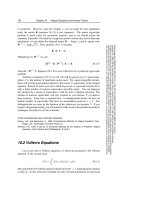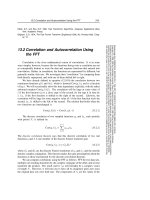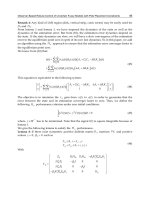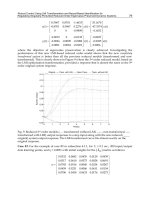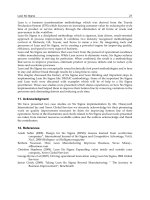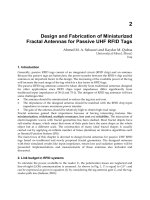Airport Layout and Design final - part 3 ppt
Bạn đang xem bản rút gọn của tài liệu. Xem và tải ngay bản đầy đủ của tài liệu tại đây (519.02 KB, 10 trang )
Elements of an Airport Master Plan
•Airport Master Plan
• Environmental Considerations
• Existing Conditions
• Aviation Forecast*
• Facility Requirements
• Alternatives Development and Evaluation
• Airport Layout Plans*
• Facilities Implementation Plan
• Financial Feasibility Analysis
*Approved by the FAA
Airport Layout Plans Drawing Set
1) Airport Layout Plan*
2) Data Sheet
3) Terminal Area Plan (s)
4) Airport Airspace Drawing (FAR Part 77)
5) Inner Portion of the Approach Surface
Drawing
6) Airport Land Use Drawing
7) Airport Property Map
Wind Rose Analysis
• Used to determine optimal placement
of runways
• If wind coverage of 95% for 10.5 knot
wind can be achieved no cross wind
runway is needed.
• Indicates probability of safe landings.Runway Designation
• Runway Placement
• Constrained By Land and Wind
•1
st
Convert to Degrees
•2
nd
Adjust for Magnetic Variance
•3
rd
Divide the bearing by 10
•4
th
Round to the nearest whole number (if
the answer is 0 use 36)
• If there are multiple runways designate
Right or Left
Angle Conversion
• The runway bearing is typically
reported as a Bearing Angle
• Runway Designation uses the Azimuth
Angle
• Problem
• A proposed runway is determined to be
N54
o
30’W, With a magnetic variance of
14
o
45’ West and an annual rate of change
of 10’ East.
•Solve
• What should the runway designation be?
Solution
1. N54
o
30’W Bearing Angle =>
305.50
o
Azimuth Angle
2. -14.75 Magnetic Variance
305.50
o
- 14.75
o
= 290.75
o
3. Divide the Bearing by 10
290.75
o
/ 10 = 29.075
4. Round to the nearest whole number
29.075 => 29
5. Runway designation 11-29
Part 3 Design Guides
• Advisory Circular 150/5300-13
• Federal Aviation Regulation Part 77
